Two weeks in residence on Santa Cruz, Galapagos.
Day 1.Saturday 25th April. 2009.
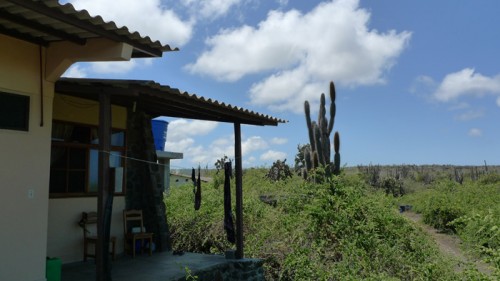
Singing finches end her sleep still bewitched by long solo walk back under star filled sky post “Launch!” the new Linblad Galapagos cruise ship cocktail party. She had balanced the evolutionary, natural historical and geological pre-trip study with Vonnigut’s “Galapagos”, so the unexpected nature and luxuriant all aboard champagne toasted dazzling canapéd first night had been perfect. The guests were also exceptional. Talking on current developments with the Director of Science for CDF and Galapagos Wild Aid representatives, along with volunteers and gallery owners – many imported from places like Australia, France, the US and UK – they had also later slipped out in small groups to explore the ex-Arctic working prawn trawler, looking for evidence of its past life like the hundreds of notches carved into the wheelhouse, each one for a polar bear sighting.
Why so many in 2007? they wondered. How many hours to take this ship now to Fernandina Island to watch the erupting volcano por favor Signor el Capitano ? Pisco sour?..another ?
At 6.30am she is almost stepping on small black iguanas digesting on the slippery ramp she gingerly traverses to find the morning swim. Crabs scuttling, brown pelican on rock, frigates gliding in blue above, with some of the iguanas coming to swim too, all of them blithely grinning in the soft shallow cool water, the tide almost out, black volcanic rocks surrounding. A boy appears with backpack, mask and snorkel and slips in fully dressed. She is thinking he’s a scientist, then a local fishing for something.
It’s later as she’s being gashed over sharp rocks by all powerful waves snorkelling from the “beach” that she realises that a calm bay is a must for swimming. The morning market has also revealed why vegetables are so sparse in los almuerzos – central London smart supermarket prices on the green stuff. Only bananas and plantain, chillis, yucca and tomatoes seem reasonable/fresh/grown on the island, the rest imported.
She has seen the “native garden” work everywhere. Who now are the natives? she’s thinking.
Day 2. Sunday 26th April.
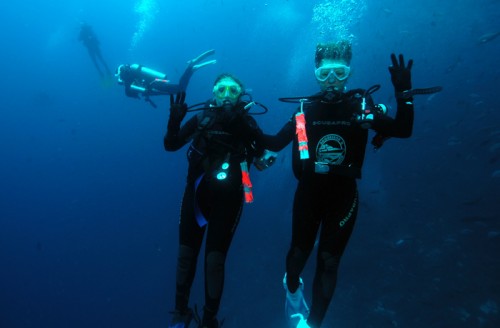
photo Richard Vera
Her fingers and toes shed skin like the peeling black marine iguanas smiling on the rocks. Seven days spending fifteen hours and twenty minutes wrapped in 7mm of sealed neoprene at depths of up to 36m in salty water has its costs. This morning swim makes a wave tossing laughing gaily gashing knee and left palm hole experience in sparkling surf. Land and water living animals here are well encased in hard thick skin and their feet grip without question. Pale skinned human animals are easily torn. A diver died yesterday, and the dive shops are quiet. He had a heart condition, was a doctor and neither he nor his wife had said anything to the dive guides.
We come so full of desire and meaning for this place stupid things easily happen. [Or is the Saturday night town so quiet as it’s election day tomorrow and no alcohol is allowed to be sold for the 2 days previous ?]
She meets the Australian doctors from the dive boat for supper again. Naomi is going through 5 days of decompression treatment for a case of skin bends that was virtually ignored to start with. It seems amazing that she should need this much treatment after comparatively so little time underwater. Do different humans have a greater propensity for the bubbles of nitrogen to lodge? She remembers the dive when she got so excited at being suddenly surrounded by hammerheads that she forgot to check her time and depth until realising she had been down for 50 min, was at 32m with only 40lb of air and a needed a 14 minute deco stop at 10ft. Thank you for air-sharing Richard. She still wears his T-shirt on days demanding special fortune.
Day 3. Monday 27th Aril.
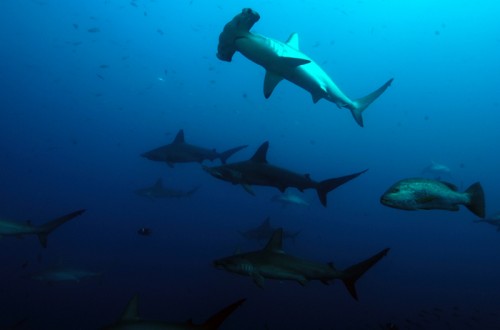
photo Richard Vera
Cesar Peñaherrera is wary, By the time she leaves he is handsome, charming and informative. They sit on the wooden balcony outside his office overlooking the startling blue sea whose waves rise and crash in white curls towards the black rocks. They talk of sharks and he shows her graphs and notes and maps to explain the “continuous tracking” ,”spot/splash”, “satellite” and “acoustic” tagging techniques Migramar, the CDF marine conservation shark project, is using. Yes they use hydrophones to listen to the ultrasonic detectors that are deployed at various points around the island collecting the tagged sharks. Yes they do listen to the sound sometimes, yes it is amazing, oh no we never record it. In London she had tried hard to be here when the scientists would be going on a field trip but it was not possible. Now she feels the disappointment.
Since the week underwater, she had decided that the hammerhead was the one to follow, and Migramar has so far collected more hammerhead tracking data than anything else. Cesar shows her a map of Wolf Island and the dark crescent shape that a shark had made from hanging out on the south east side of the island there all day. At night it had gone east into the ocean and come back again at dawn. Five hammerheads had been tagged and they all did this except one which had disappeared making a beeline for Cocos island. They are currently developing a shark superhighway theory.
She’s gripped and wants to become a shark scientist.
Day 4. Tuesday 28th April.
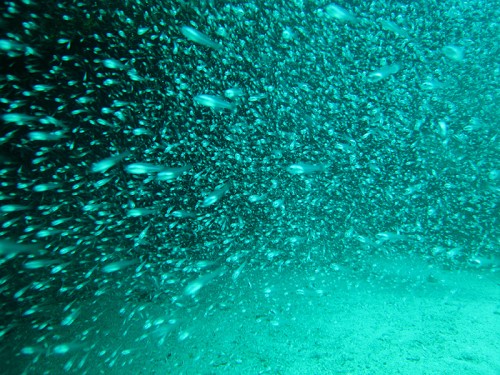
Cesar asks how much of the data she wants to use and she says all of it. He is perplexed and reveals that many others are involved in this work and they will need to be asked if sharing their data is OK . “Of course” she agrees and by way of explanation pours forth an articulate monologue presenting the size of her intention with this work, that these are just their first meetings, that she doesn’t imagine completing anything for two years or so at least. That none of the data would ever be revealed as numbers but would just be used to process sound and make scores. That any feedback and collaboration from him would be superb. He seems assured, even interested. Yes this work is massive and ongoing and this is good and they have a communication.
It turns out that James, the hammerhead tracker, is based at UCDavies, University of California where she hopes to go and collaborate in the Allosphere at UCSB on this work anyway. She interprets this as a fortuitous link.
As they close the meeting, she tries the beguiling method on Cesar, still hoping that he will have time to go and collect the fallen shark tag beeping static and lonely in the bay. He is more than busy with reports he has to write he repeats. Of course everyone is too busy for a visiting artist, classified as a tourist, certainly not a researcher. The Galapagos National Park, the surrounding sea and all its eleven islands, is a controlled zone and humans can only go to certain places. There are tourist areas for Park entry paid visitors ($100 per head for up to 3 months), and scientists have to make proposals to the Park to gain permission for their field trips. The two type of visitor don’t meet.
She is desperate to be in water land with sharks again she realises.
Day 5. Wednesday 29th April.
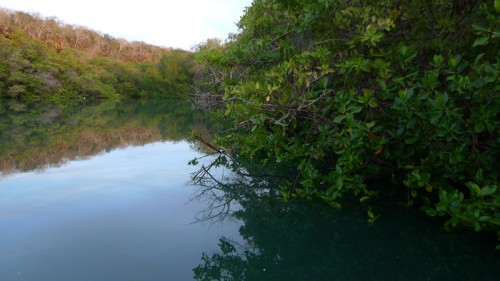
The most accessible place for still underwater recordings here is the laguna in town. She still needs to be able to record what’s inside the ocean. Recordings from the dive boat via a rubber Zodiac had always produced surface noise even with the hydrophones at 20m. Dropping cables into still deep water from the coast seems a solution she proposes. Cesar suggests the Canal de los Tintoreras (shark channel ~ los tintoreras is the local name for the small white tipped reef shark), but Felipé proposes this Laguna de las Ninjas, making it clear that she‘s not allowed to go to the canal as it’s a tourist place so only visited by boatloads of them at certain times.[A researcher needs a proposal and maybe a 6 month wait for a possible permission from the park to go.]
Elke had shown it to her yesterday when at 4pm it was noisy with swimmers and entwined romantics. It was also surrounded by mangrove, seemed small next to the vastness of the ocean and only a few metres deep. Not what she had in mind. She was disappointed. Ideas and expectations that had grown during the diving week were being fast trashed.
Today she still goes there though at dawn. The 30 minute walk from the station through the waking town is golden pink and delicious. At the laguna, the surface is static, the air quiet and inside the water she finds it so clacky and cracky she is amazed. Beneath the town’s swooshing harbour water by contrast it’s almost quiet it seems so empty. God she knows so little about life and sound underwater.
5pm and they meet Captain Tito Franco on the pier . He is the fisherman who takes out the shark scientists when they go to sea on tagging expeditions. He tells how the launch of Migramar was triggered by fishermen who in 1995 wanted to show that the decreasing shark population was not their fishing but the fact that sharks migrate to follow the fish stock. He reveals that he is a shark hypnotist and the one who catches the shark to be tagged. She is transfixed and they arrange an expedition for Friday.
Day 6 Thursday 30th April.
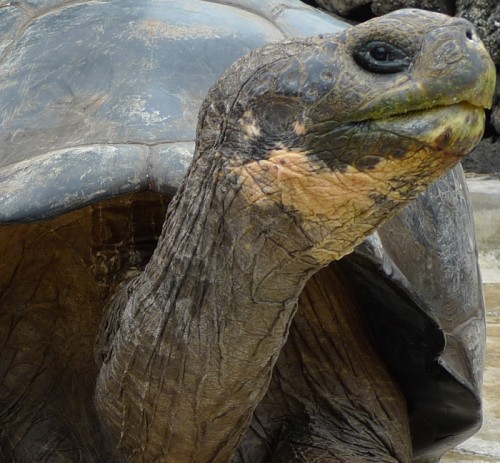
At dawn she goes out to record birds but discovers male tortoises rutting and groaning, their shells crashing and dry skin rasping like breath. Finches are prancing in pairs, the chubby males fluffed up, wings spread, doing spinning Cherokee dances in front of the ladies, dipping and diving and squawking as zithers. The girls continue to hop along eating looking the other way.
9am and she meets Elke. It has rained. Rare delicious cool heat smell perfect rain . The flip flop seller says the beach will be fine. They are walking over to Bahia Tortuga and the 2.5km path through the prickly pear forest is long and yes boiling. It ends though on a paradise beach. White sand as soft and fine as flour and going on so far with no-one around. The sea rolls in from far blue through green aquamarine tipping white to land. There’s a red algal bloom in the middle, it’s often there, and fish called Lisa love says the man at the gate. Far down the right side of the beach they come to a still lagoon. It has a low rock cliff down one side from which she drops her hydrophones. The pool is still, the life inside snapping and bustling. This is good and so quiet.
A tourist boat rolls up chucking out tourists and pumping salsa music which filters into the still underwater. It makes a good sound track for the cactus forest sculptures she films. Her focus on the work is so intense, stunning, that she forgets the time, runs out of water plus sunscreen and has to remember West Australian bush walking techniques she developed in 1998 to make it back the 3km to the man at the gate not too delirious. He has cold agua con gas and more stories about Lisa fish. Her Spanish is so feeble though that who knows what they really say to each other ?
Whatever, they pass a good half hour on smiling sideways stories, enjoying the communication whatever the comprehension. There were maybe 3 other people on that huge beach all day and he’s there alone in his hut with fridge full of cold drinks to sign the visitors in and out of this Galapagan paradise.
It is 5pm and she thought it was 2.
Day 7 Friday 1st May.
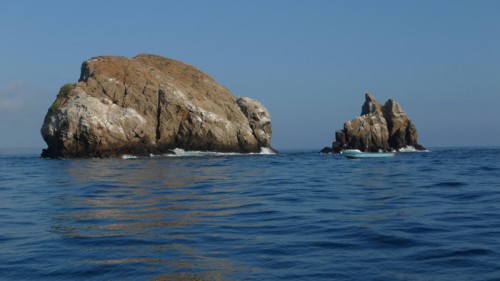
The rain has affected the telephones and the 5am wake up call doesn’t come. She wakes anyway and is only a little late to meet Captain Tito and Felix, the skipper of the boat they are to go in. She should have realised then. The boat is fibre-glass so will be slappy and noisy as hell out at Seymour rocks in shark loving waters with a current and a swell, but she is 6am stupid and blinkered by the thought of shark hypnotism’s secrets about to be performed not to mention the blue blue Galapagos morning. In fact she is so excited with anticipation it’s perfect. Yes, this trip is to witness Captain Tito hypnotise a shark. He has caught sharks for the UCDavies researchers to tag as well as being at the centre of struggles between local fishermen wanting to hang on their fishing rights, and government restricting or removing them due to huge drops in species numbers. It’s complicated and ongoing and she slaps herself again for her feeble Spanish comprehension.
They spend all day recording in fast current shark hangouts, also being visited at the surface by a 6m hammerhead circling close but none are to be hypnotized.The last recording ends the trip. It’s the stillest one yet and delicious at last when crunch whack distortion smacks in and the line goes dead. Up comes the mic. She thought the cable would be empty. But no, the mic is there and bitten. Destroyed by a Mexican Hogfish they reckon. She can’t believe the horror.
A slab of grilled wahoo, rice and beans and copious quantities of cold beer with the fascinating Russian red ant expert neighbour from Texas, later that night puts things in perspective. What a day.
Day 8 Saturday 2nd May.
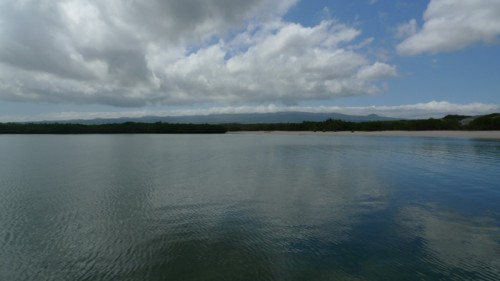
This Saturday she makes the market early and finds mountains of locally grown fresh chard, lettuce, broccoli, tomatoes, carrots, squash and bananas. The prices are fair and her communication skills far developed. She even manages conversation. Its fantastic.
She is to have a day off and gets to Tortuga beach just as the sky greys and rain falls. The lagoon is warmer than sheltering under small trees, so she swims snorkelling up towards the sea where a boat has anchored, its guests in the water. She sees it is Felix with his family and the word los tiburones bounces across the surface. They count twelve los tintoreras swimming around in a wee cave at the side. She gets to swim with them after all !
Interesting. It’s almost scary being on the surface with sharks, totally different to being in the underwater world with them. She feels naked, white and vulnerable. This is when they like to nip you. But the locals are practiced, and they hover quiet and still as water-boatmen watching and watching and greedy and watching.
Later lying on the beach she consumes Mike Figgis’s book on making digital films. His down to earth and generous approach is inspiring and reprimands her for not being up to date with logging all that footage. She has loads, much to be chucked, but she is learning with a small lightweight camera and its 16GB dumpable cards are perfect for this.
As with recording anything, she’s also learning what she can’t record. It’s not possible to capture this. This moment. This steel still. Not a breath of wind. A bright break in the cloud suddenly lighting up the prickly pear forest. The dark grey sky overhead. A group of kids breaking the static surface of this vast shiny water playing volleyball, their arms waving.
Day 9. Sunday 2nd May.
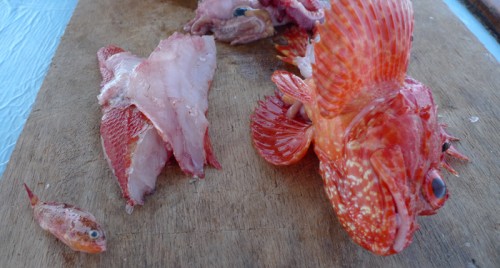
7 am, Sunday morning fishing with Tito and Felix. Another stunning sunny morning, the boat swarming and bouncing out over the flashing harbour water. Thirty minutes later and they are catching. Felix manages six different types, gutting and filleting the little fancy red ones for bait, dropping the others into a big grey plastic tub. They see and find no shark. Odd.
In the 1970’s in the Mexican Eastern Pacific, divers were regularly seeing 100 sharks per dive. Now they might find about 10. In the Galapagos Marine Reserve, an illegally poached and slaughtered shark can make $2,500. Shark finning still exists. The consumption of shark fin soup is in fact on the increase. it still retaining social status in China as well as becoming cheaper. Sharks are caught and eaten all over the world in increasing amounts as other fish stocks dwindle. This includes the neighbouring Ecuadorean waters outside of this Galapagos Marine Reserve. Is it big enough?
Shark numbers worldwide are hugely on the decline. If we continue like this and lose this essential top of the chain predator, this ancient species, whose earliest versions predate the dinosaurs by about 100 million years, we are in danger of damaging the marine ecosystem and abundance of other fish species in ways that cannot currently be predicted.
[ The End of the Line?” ©2007 WildAid, marine ]
Felix gives them half the grouper and they drop in at the Rock bar where the chef fillets it as they sip fresh squeeze lime water cold. Relief. It is 35C midday and they are wobbly up and down from six hours in the fishing boat. She asks for local advice on how to cook it and the technique involves mustard+lime marinading, a light dip in maize flour then pan fried fast. The essential thing is to fry the bone he says. You must fry and eat the bone. She eats trout bone like this at home, so that day she does the fillet –Sunday lunch! – and the next fries the bone. It’s stunningly savoury and fishy all at once. She makes the head and fat cheek into soup with squash and tomatoes and garlic and hungos and aji para seco which in the store she had thought was chilli powder but it’s not. In fact she still doesn’t know what it is apart from a condiment naturale that makes everything taste great and look a bit red. Achote? (Her t-shirt is still stained in the stuff after Carlos’s body painting in the jungle.)
Day 10. Monday 3rd May.
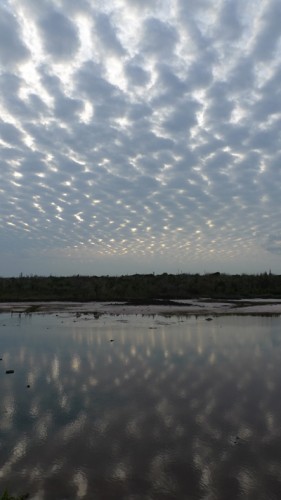
The light at 6am is very different to normal and the path is black. It obviously rained a tonne in the night and she heard nothing. The fish bitten mic she has to acknowledge is not going to be replaced. Still no answer from DolphinEar mics and she doubts there’s now time to make a delivery anyway. So she plans single channel recordings as she swims in the bay. She still doesn’t understand the high and lows of the tide. At 6am it’s usually low and today it’s high and swelling with murky brown visibility.
For her underwater recordings she is using DAT thanks to the wonderful Fabiano in Quito as the phantom power on her Fostex collapsed in the jungle all those weeks ago. She had feared that those recordings would be terrible as a result and had not really listened to them since. Here though she faces them and is delighted. They sound amazing. Full of that wild jungle life, noisy, zappy, fast, hard edged, communicative, multi-layered and intricately organized. The birds that call to each at the start of the night are clearly there, occasionally soloing flute like. Better still she hears the circumferential shape of that jungle space. Yes, those determined dusk recordings, sitting static with mics carefully and carefully re-positioned up trees had caught a sense of it.
She realizes now that again there, like underwater, she would switch out of the reality of the event – ie. alone in a night falling Amazon virgin rain forest – and would invariably be feeling her way back through the dripping tripping trees in the sudden descent of the black equatorial night, arriving relieved and laughing for supper with the boys yelling, “Ah! but the jungle is a veritable orchestra! “
Now on Galapagos she has made some comparison recordings with DAT and Fostex and Edirol, and the DAT is unquestionably superior. There is a softness/textured brilliant clarity in the recordings that the Fostex misses. She even contemplates looking for one on eBay but dismisses the idea. Practically it’s too big and heavy, especially with its power supply, and tape now seems so vulnerable next to card. Funny, they use to seem army like robust next to cassette. Also though, how much longer will DAT tapes be available now that they’re no longer made? In the whole of Quito they had only found two 94 minuters. Another no to DAT for her is the memory of mastering her first cd Ann, and being sickened that the CD just would not sound as good as the DAT. Is it just its playback that sounds so good? The analogue versus digital divide once more?
Now with only her headphones to test, she can’t be sure. However, Freddy in AV here at CDF is being super helpful.He has an air conditioned office with PC and audio equipment and they dump the recordings, Yes there is a difference, but at least she has a back up. Better still, the hero produces 2 tapes she can reuse from the bottom of a dusty box. They also hilariously teach each other English and Spanish and she shows him stereo.
Ah.
Day 11. Tuesday. 4th May.
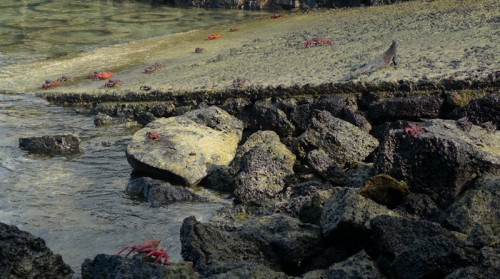
She crawls out of the sea dripping and crab-like up the ramp, a veritable local accompanied by two small black iguanas at either shoulder, all three blithely grinning. As she dries she suddenly understands the frequent smell of cow dung down here. The iguanas have paused with the weight of their bellies on the heat of the rocks and one of them releases pungent bright green shit. A finch appears and hops on its back. It lightly pecks its skin, hops off, comes round the side and pecks its shoulder. Both are calm and happy and appear as old pals.
Elke calls. There is good news from Daniel Rivas, the co-ordinator at Fundación Charles Darwin on Isabela island. Angel Gunsha the prinicipal of the Escuela Municipal Jacinto Cordillo in Puerto Villamil, is not only able to provide a space and a group of eleven year olds to work with for five days, but is more than enthusiastic about it. Great. The planned trip to Isabela will work with locals after all. She had proposed to go work with eleven year olds there. Go play them her recordings, talk sharks and underwater and see if they wanted to make music with her for a few days. Now she needs to plan how to do it. The call also revealed that, as she expected, there is not an amp or a pair of speakers or a ghetto blaster to be had, let alone computers or the internet. [Although Isabela is the biggest island in the archipelago, currently it has 2000 residents, is a small fishing community so a far cry from the bustling tourist driven organization of this, Santa Cruz. ]
5.45pm and Captain Tito is an hour late for the interview on the fishing dock. The seal and the dog are there even though the fishermen and the catch and the pelicans and the crane have long left.When he arrives the light is great but dipping fast. Within twenty minutes it is dark and they stop and reschedule for tomorrow early, all madly scratching at rising bites from the clouds of tiny vicious mosquitoes that attacked as the tape rolled.
The prancing upright flightless bird that jumps out on the starlit path home looks fresh from Pixar. She discovers it’s a greater crested night heron and their life expectancy is 30 years.
Pre Galapagos Landing research Trip.